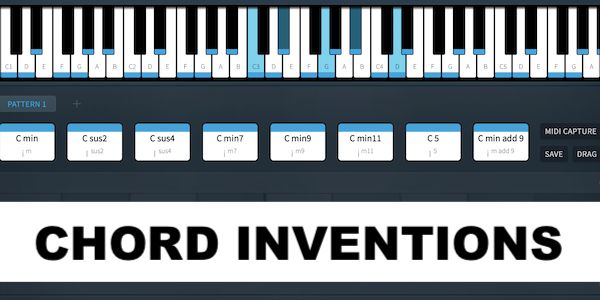The use of certain chord types such as triads and extended chords have become the staple of chord progressions. One way to expand this palette is to layer different chord types together and invent new chord types. This gives you greater control of the voicing and harmonic sound of your chord.
Try this process.
1. From your song’s scale, select a root note for your chord. For example, if your scale is C minor, you could select the note C.
2. Identify all the chord types that will have notes in your scale. In the C harmonic minor scale, possibilities for the root note of C are Cminor, Cm7, Cm9, Cm11, Csus2, Csus4, Cm added tone2, Cm added tone4, Cm added tone 6.
3. Now, try layering these chords together and see how they sound. For example, play the C minor ninth and C added tone 6 chords together. Some notes may overlap due to there being common notes in the different chords.
4. Now, try inverting and duplicating notes in the chord above or below the current octave.
5. Try removing some notes
You’re now creating your own chord types.
Here’s an example of a layered chord. With a root note of F#, it’s created by layering the chords of F#add2 (added tone 2) and F#add6 (added tone 6). The F#add2 chord contains the notes: F# G# A# C#. This is then layered with a F#add6 (F# A#C# D#), which effectively adds a D# to the F#add2 chord. The root note (F#) is then doubled an octave above.

You could also create unique chord progression by moving between your own chord types. As you move between these, think about the changes in chord voicing.
Use a combination of sustained notes and different notes between the chord changes. The sustained notes will create a smoother sense of voicing while providing more focus to the notes that change.
Here’s an example of a chord progression which expands the layered chord (above) into a four chord progression.
In the key of Bb natural minor, the progression moves from the F# major chord to Fm to Bbm in the third and fourth chords. The second chord is an Fmadd4 (F Ab Bb C) layered with an Fmadd6 (F Ab C Db) layered with an Fm7 (F Ab C Eb). The root note is also doubled an octave higher. The third chord is a layering of a Bbsus2 (Bb C F), Bbsus4 (Bb Eb F) and Bbm7 with the minor 3rd (Db) removed from the chord. In the fourth chord, the Bbsus4 and Bbm7 chords are layered with the minor 3rd (Db) removed. The root note (Bb) is doubled an octave up.
There’s a number of sustained common notes throughout the progression, notably A#2 and D#3 and notes which are held throughout only some of the chord changes such as F3, G#2 and G#3. There are also notes that change between two chords such as F#2 to F2 and F#3 to F3, which add a sense of melodic movement.
Layering traditional chord types can create interesting hybrid chords and expand the options for harmonic progressions.



